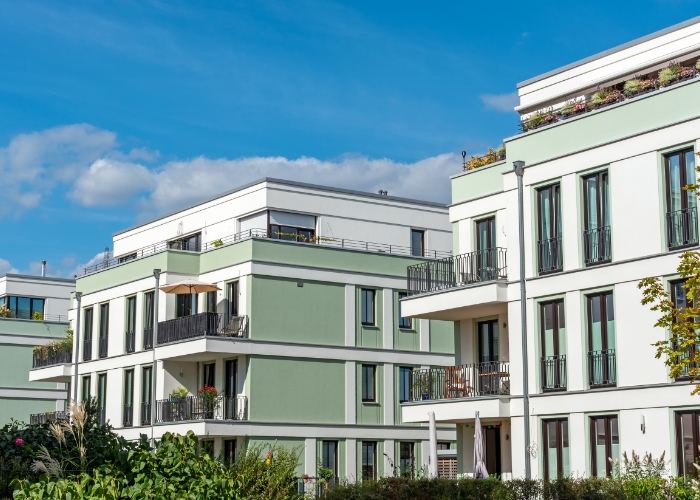Applications to purchase and refinance rose 1.2% and 2%, respectively
The Mortgage Bankers Association (MBA) reported that applications to purchase and refinance both rose in the last week of July. Applications to purchase a home rose 1.2% from the previous week, while applications to refinance a home loan rose 2%.
While refinancing applications were up 2% week over week, this still represented a decline of 82% since the same time last year. Applications to purchase, though also up, were still down 16% from the same time last year. Still, the increase is good news for the housing market, as it shows that market activity is not slowing in the near term, with more people interested in buying or refinancing a home. This is despite interest rates hovering near 20-year highs and home prices at or near all-time highs.
So what does this mean for multifamily rental properties? Expert opinions vary, but many believe that these numbers are a good sign for residential rentals, as they reflect an ongoing housing shortage that leads to strong market activity in the face of rising interest rates and many housing markets priced at all-time highs.
Housing market on a correction course
Despite recent upticks in mortgage applications, high housing prices and the Federal Reserve’s struggles to curb inflation have many experts worried that the housing market may be headed for a correction. These impacts may be exacerbated as long-delayed housing developments come back online after being paused due to Covid-19 and subsequent building supply shortages.
A correction course could mean that housing prices are set to decline over the next six to 24 months, though most experts agree that price declines like those seen in 2008 are unlikely. Instead, many believe that many housing markets are set to enter periods of slower price increases, as housing supply catches up with demand and interest rates settle out at a new increased level.
This is a good time for buyers to invest in real estate, as they will have more negotiating power and more choices. Sellers, on the other hand, may need to be more flexible on price. If you’re thinking of buying or selling an investment property, now is a good time to refinance and explore other deals in your area.
Interest rates in July fell to lowest level since April
A decrease in mortgage activity year over year has forced lenders to remain competitive in home financing despite the Fed recently raising interest rates in an effort to combat inflation. Interest rates fell in July to their lowest level since April, as concerns about the economy continue. The yield on the 10-year Treasury note fell to a low of 2.67% in July (versus a low of 2.39% in April), while the 30-year mortgage rates fell to a low of 5.3% in July (versus a low of 4.72% in April).
Many economists think that further rate increases will be necessary, as the Fed’s continued efforts to slow inflation—and the effects of these rate hikes on mortgage rates—remain to be seen. Many investors are taking advantage of this recent dip in interest rates to close on new investment properties or refinance properties in their portfolio.
US GDP fell at 0.9% annual rate in second quarter
The US economy shrank at a 0.9% inflation- and seasonally-adjusted annual rate in the second quarter of 2022, according to the latest data from the Commerce Department. This is after a 1.6% decline over the first three months of the year.
These numbers reflect continued strain from slowdowns caused by global supply chain issues in the wake of the Covid-19 pandemic. Likewise, individuals and corporations are experiencing these effects in the form of delayed construction projects, stalled auto manufacturing, and reduced energy production due to high prices.
The fall in GDP is also due in large part to inflationary pressures. Simply put: there are fewer investors with the cash to do deals, and many smaller investors may be looking for opportunities to liquidate their properties.
This makes it a good time for investors to accumulate real estate, as the value of these properties is likely set to continue increasing over time as replacement costs rise. This is in response to likely increases among construction prices, as the costs of raw goods and materials increase in response to inflationary pressures.
New jobs numbers reveal 528k added in July and unemployment down to 3.5%
The Bureau of Labor Statistics (BLS) July jobs report released on August 5 was better than expected, with the economy adding 528,000 jobs and the unemployment rate falling to 3.5% (the lowest since the late 1960s). This was the 19th consecutive month of job growth, which served as a solid indication that the economy is continuing to recover from the pandemic-induced recession.
This was also the highest monthly jobs increase since February, when US employers added 714,000 jobs. Over the last four months, the economy has added almost 400,000 jobs per month. One notable standout, the construction industry added 32,000 of these jobs in July—this represented a 4.2% increase year over year. Gains included 18,300 jobs for nonresidential construction, with 10,300 positions going to specialty trades.
Still, high materials prices and a dearth of skilled construction workers have slowed down progress on existing projects. And these lower unemployment numbers mean the shortage of workers is expected to continue, especially as new government infrastructure projects get off the ground.
All told, these numbers indicate an economy entering recovery mode, though still being held back by labor shortages in several key sectors that may prevent the economy from growing at its previous pace.
